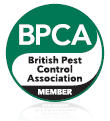
- Belfast: 028 9079 6026
- N'Ards: 028 9181 8313
- M: 07968 155 703
- E: info@ppcenvironmental.co.uk
Cockroaches & Insects
Cockroaches are potential vectors of diseases such as dysentery, gastroenteritis, typhoid and poliomyelitis. Their diet is omnivorous and includes fermenting substances, soiled septic dressings, hair, leather, parchment, wallpaper, faeces and food for human consumption. The latter may be contaminated either by the mechanical transfer of causative agents of disease from the insect’s body, or by transmission in the faeces. An outbreak of food poisoning in a Brussels hospital subsided immediately an infestation on B. germanica was controlled.
 Cockroaches and their faeces may cause allergic reactions especially amongst sensitive individuals e.g. asthmatics. Exposure may result from ingestion or through the inhalation of materials derived from cockroaches in airborne dust. In addition, food may be tainted with the characteristic smell of the cockroach, which is produced by faeces and salivary / abdominal gland secretions, or by the dead insects.
Cockroaches and their faeces may cause allergic reactions especially amongst sensitive individuals e.g. asthmatics. Exposure may result from ingestion or through the inhalation of materials derived from cockroaches in airborne dust. In addition, food may be tainted with the characteristic smell of the cockroach, which is produced by faeces and salivary / abdominal gland secretions, or by the dead insects.
Control (See Professional Advice)
Successful control of cockroaches is a complex subject, and depends very much upon tailoring control measures to the species concerned.
Assessment of infestations
An assessment of the infestation must be made to determine the species and extent of the infestation. Plans of the area will be required. The entire site should be inspected, including where appropriate adjoining premises, normally inaccessible places, drains etc. A night survey is useful as this is the time of maximum insect activity.
The survey may be carried out using cockroach monitoring traps, searching for droppings, cast skins and egg cases etc. A pyrethroid-based aerosol sprayed around and into potential hiding places will flush out cockroaches (other than the Oriental cockroach).
Control Measures:
(A) Hygiene / Management
A high standard of hygiene is important in the control of cockroaches and involves the following components:
- Deny access to food and water. This will increase cockroach activity and directed movement improving the opportunity for insects to encounter insecticides.
- Deny access to harbourages in buildings or equipment which would otherwise provide hiding places, a means of gaining access and dispersing and breeding sites.
- Ease of cleaning. Buildings and equipment should be designed to minimise the accumulation of debris and facilitate ease of cleaning.
- Surveillance of incoming materials including packaging and laundry.
- Environmental controls e.g. ventilation which will accelerate dehydration of the insect and interfere with the operation of antennal chemoreceptors.
(B) Insecticidal Control
Surface Sprays
Effective treatment depends upon the selection and thorough application of a suitable insecticide. Many insects and egg cases are well hidden; therefore, the insecticide must be placed at and around these harbourages and maintained over the developmental period of the particular species. To control an infestation the insecticide should ideally persist until all egg cases have hatched but continued immigration may demand routine treatments.
Space Sprays
Regular treatments are necessary e.g. at weekly intervals until the infestation is brought under control. Thereafter, maintenance treatments, at less frequent intervals, should keep the insect population at an acceptable level. Initially there will be a massive kill of adults and nymphs resulting in only the appearance of young nymphs from time to time. The technique is particularly useful using pyrethroid insecticides to flush cockroaches from their harbourages and over surface deposits of insecticide.
Insecticidal Baits
Baits offer the opportunity for controlled placement of insecticides formulated in attractive food bases. When placed in areas infested with cockroaches, the insects feed on the baits picking up a lethal dose of insecticide in the process. Baits offer the opportunity for continuous control of cockroaches over extended periods. They can be integrated with surface or space spray treatments.
More Information – Cockroaches PDF Factfile


























